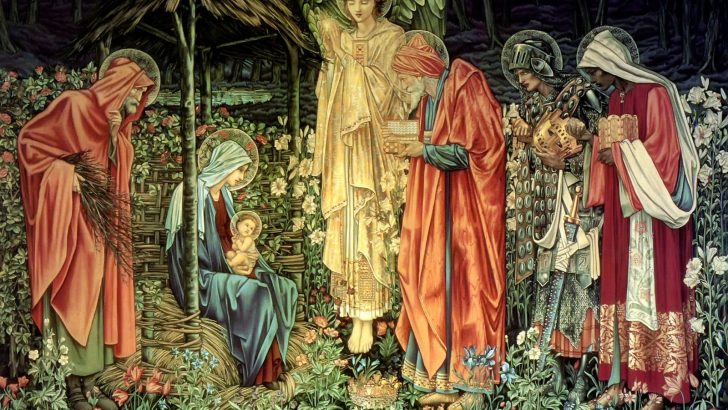Fr Conor McDonough
We must protect “the world (that) is more than just decay” writes Fr Conor McDonough as, “it is a place also of birth, of new beginnings”
There is something immensely moving about the feast of Epiphany: bearded old men leave their dusty old books and journey by the light of a star to a site of utter newness, the birth of a child, ‘God with us’.
Decay is a feature of our fallen world: civilisations grow decadent, institutions crumble, bodies fail, ‘things fall apart’. If our field of vision is limited to these phenomena, logic leads us to what St John Paul II called “the culture of death”. If life is a rocky road to nowhere, why preserve it, why protect it?
But the world is more than just decay. It is a place also of birth, of new beginnings, of ‘newness in every stale thing’. In the beginning, God created the world, and created it with this capacity for its own renewal, but after the Fall he redeemed it, offering the life of grace in the midst of decay. And it is no surprise that this redemption was first shown to us in the form of a newborn child.
The philosopher Hannah Arendt had a special term for the human capacity for newness: ‘natality’ (from the Latin term for birth). Instead of viewing us as beings that tend towards death, and live always in the shadow of death, Arendt viewed human life in the light of birth. Natality is ‘the miracle that saves the world, the realm of human affairs, from its normal, “natural” ruin’.
For Arendt, natality is the source of hope, since it is this capacity for renewal at any given moment that delivers us from determinism and decay.
It’s a strange word, but we all know the reality it refers to: when a child is born, when a sinner converts, when a smoker gives up cigarettes or a drinker gives up the bottle, when a scientific experiment gives a new perspective on the world, when an ancient grudge is set aside and forgiveness is offered and received. All these are examples of natality, outposts against the conventional cynicism that says, in well-worn words: ‘There is nothing new under the sun’.
Of course, any humanist with their eyes open can appreciate that natality is something built into human nature, but the Christian ought to be even more sensitive to it, since we know God not only as Creator, but as Redeemer: we live every moment of our lives in the light of two births, our natural birth, and our supernatural birth in baptism.
In contemporary Ireland, we have a complex attitude towards natality. In some contexts, we are united in affirming the value of life.
In our work against suicide, for example, we happily affirm that life is always worth living, that hope is possible even in difficult circumstances, that something new is always just around the corner. And yet, in public discourse on abortion and euthanasia we often qualify this affirmation: ‘Life is worth living unless…’
So, at the start of 2017, as we celebrate the worship by the Magi of the newborn Jesus, I want to salute the ambassadors of natality, the frontline defenders of hope: the activists, volunteers, and supporters of the pro-life movement in Ireland, who refuse the ‘unless’ of popular opinion, and affirm again and again that life is always worth living. I know how much it costs many of these courageous men and women to carry out their work in the face of opposition, apathy, and derision.
They get little thanks, and little recognition, and they need our collaboration and support. 2017 will be a crucial year for the culture of life in Ireland. Why not make this the year you take a stand for hope.
John Halligan’s unique ‘Christmas’ cards: Not everybody has the same taste in Christmas cards. Some like kitsch and cute, others go for sober solemnity. Some could never countenance a card that lacks a Nativity scene, others are content with a few seasonal shapes and colours. But Waterford TD John Halligan’s alien-themed Christmas cards are surely unique. Isn’t it interesting that he chooses to replace imagery of the Incarnation with extra-terrestrials, as if these aliens represented a non-divine promise of hope? In 2011 his card explicitly made this connection, showing a variant on the famous creation scene from the Sistine chapel, but with the hand of God replaced by the slender fingers of a blue ET. Some hope: if aliens do exist, they are creatures just like us, bound to the same natural patterns of decay, offering no salvation, no escape from creation’s groaning. Hope is traditionally counted as a ‘theological virtue’, because it has God (theos in Greek) as its object – only the creator of the world can offer hope to a world gone wrong.
How to exercise hope in the face of war and savagery? Our Dominican brothers and sisters in Iraq are united in their response: in the face of war, you educate. Following the advance of ISIS, our sisters became refugees and were forced to relocate to the camp in Ein Kawa. There, with the aid of Catholic charities, they have already built a school for the displaced children, helping them move on from trauma by activating their curiosity and creativity. In Baghdad, our brothers run an ‘Academy of Human Sciences’ where 5,000 Iraqi students (80% Muslim) keep alive the fundamental questions of human existence. In the face of physical violence, the mind can become a zone of freedom. And to take on the task of inspiring young minds in a warzone is a true act of hope: with the help of God, war will end, and hearts and these young minds must be prepared for peace.


 Fr Ronald Rolheiser
Fr Ronald Rolheiser
